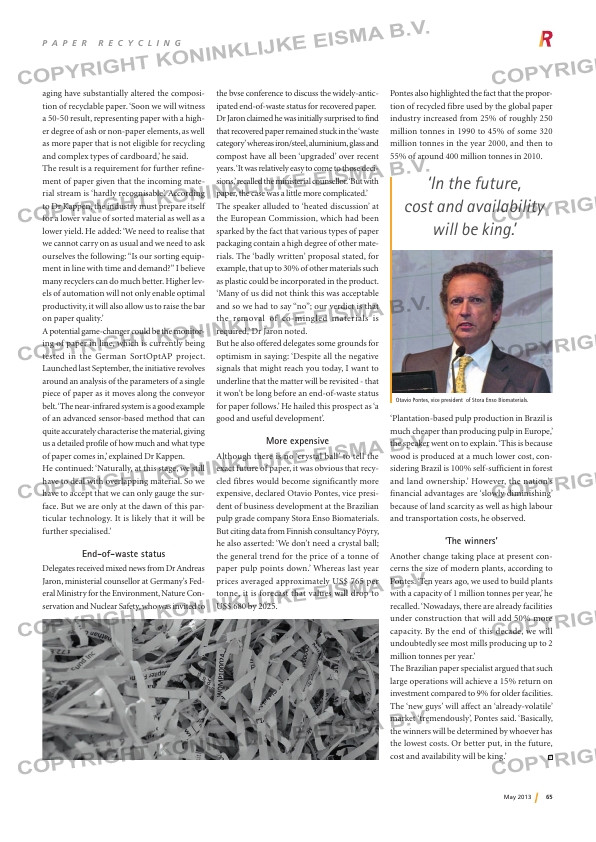Page 65 from: May 2013

65May 2013
P a P e r r e c y c l i n g
aging have substantially altered the composi-
tion of recyclable paper. ‘Soon we will witness
a 50-50 result, representing paper with a high-
er degree of ash or non-paper elements, as well
as more paper that is not eligible for recycling
and complex types of cardboard,’ he said.
The result is a requirement for further refine-
ment of paper given that the incoming mate-
rial stream is ‘hardly recognisable’. According
to Dr Kappen, the industry must prepare itself
for a lower value of sorted material as well as a
lower yield. He added: ‘We need to realise that
we cannot carry on as usual and we need to ask
ourselves the following: “Is our sorting equip-
ment in line with time and demand?” I believe
many recyclers can do much better. Higher lev-
els of automation will not only enable optimal
productivity, it will also allow us to raise the bar
on paper quality.’
A potential game-changer could be the monitor-
ing of paper in line, which is currently being
tested in the German SortOptAP project.
Launched last September, the initiative revolves
around an analysis of the parameters of a single
piece of paper as it moves along the conveyor
belt. ‘The near-infrared system is a good example
of an advanced sensor-based method that can
quite accurately characterise the material, giving
us a detailed profile of how much and what type
of paper comes in,’ explained Dr Kappen.
He continued: ‘Naturally, at this stage, we still
have to deal with overlapping material. So we
have to accept that we can only gauge the sur-
face. But we are only at the dawn of this par-
ticular technology. It is likely that it will be
further specialised.’
End-of-waste status
Delegates received mixed news from Dr Andreas
Jaron, ministerial counsellor at Germany’s Fed-
eral Ministry for the Environment, Nature Con-
servation and Nuclear Safety, who was invited to
the bvse conference to discuss the widely-antic-
ipated end-of-waste status for recovered paper.
Dr Jaron claimed he was initially surprised to find
that recovered paper remained stuck in the ‘waste
category’ whereas iron/steel, aluminium, glass and
compost have all been ‘upgraded’ over recent
years. ‘It was relatively easy to come to those deci-
sions,’ recalled the ministerial counsellor. ‘But with
paper, the case was a little more complicated.’
The speaker alluded to ‘heated discussion’ at
the European Commission, which had been
sparked by the fact that various types of paper
packaging contain a high degree of other mate-
rials. The ‘badly written’ proposal stated, for
example, that up to 30% of other materials such
as plastic could be incorporated in the product.
‘Many of us did not think this was acceptable
and so we had to say “no”; our verdict is that
the removal of co-mingled materials is
required,’ Dr Jaron noted.
But he also offered delegates some grounds for
optimism in saying: ‘Despite all the negative
signals that might reach you today, I want to
underline that the matter will be revisited – that
it won’t be long before an end-of-waste status
for paper follows.’ He hailed this prospect as ‘a
good and useful development’.
More expensive
Although there is no ‘crystal ball’ to tell the
exact future of paper, it was obvious that recy-
cled fibres would become significantly more
expensive, declared Otavio Pontes, vice presi-
dent of business development at the Brazilian
pulp grade company Stora Enso Biomaterials.
But citing data from Finnish consultancy Pöyry,
he also asserted: ‘We don’t need a crystal ball;
the general trend for the price of a tonne of
paper pulp points down.’ Whereas last year
prices averaged approximately US$ 765 per
tonne, it is forecast that values will drop to
US$ 680 by 2025.
Pontes also highlighted the fact that the propor-
tion of recycled fibre used by the global paper
industry increased from 25% of roughly 250
million tonnes in 1990 to 45% of some 320
million tonnes in the year 2000, and then to
55% of around 400 million tonnes in 2010.
‘Plantation-based pulp production in Brazil is
much cheaper than producing pulp in Europe,’
the speaker went on to explain. ‘This is because
wood is produced at a much lower cost, con-
sidering Brazil is 100% self-sufficient in forest
and land ownership.’ However, the nation’s
financial advantages are ‘slowly diminishing’
because of land scarcity as well as high labour
and transportation costs, he observed.
‘The winners’
Another change taking place at present con-
cerns the size of modern plants, according to
Pontes. ‘Ten years ago, we used to build plants
with a capacity of 1 million tonnes per year,’ he
recalled. ‘Nowadays, there are already facilities
under construction that will add 50% more
capacity. By the end of this decade, we will
undoubtedly see most mills producing up to 2
million tonnes per year.’
The Brazilian paper specialist argued that such
large operations will achieve a 15% return on
investment compared to 9% for older facilities.
The ‘new guys’ will affect an ‘already-volatile’
market ‘tremendously’, Pontes said. ‘Basically,
the winners will be determined by whoever has
the lowest costs. Or better put, in the future,
cost and availability will be king.’
Otavio Pontes, vice president of Stora Enso Biomaterials.
‘In the future,
cost and availability
will be king.’
RI-4_Paper RI BVSE.indd 65 06-05-13 14:25



